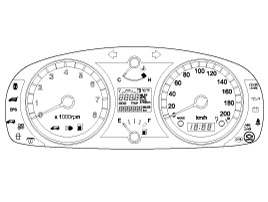
Engine is hard to start or does not start at all.
Unstable idle.
Poor driveability
If any of the above conditions are noted, first perform a routine diagnosis that includes basic engine checks (Ignition system malfunction, incorrect engine adjustment, etc.). Then, inspect the Diesel Engine Control system components with the HI-SCAN (Pro).
Before removing or installing any part, read the diagnostic trouble codes and then disconnect the battery negative (-) terminal.
Before disconnecting the cable from battery terminal, turn the ignition switch to OFF. Removal or connection of the battery cable during engine operation or while the ignition switch is ON could cause damage to the ECM.
When checking the generator for the charging state, do not disconnect the battery '+' terminal to prevent the ECM from damage due to the voltage.
When charging the battery with the external charger, disconnect the vehicle side battery terminals to prevent damage to the ECM.
Faults with the following items will illuminate the MIL.
Mass Air Flow Sensor (MAFS)
Vacuum Modulator for EGR
Refer to "INSPECTION CHART FOR DIAGNOSTIC TROUBLE CODES (DTC)" for more information.

Faults with the following items will illuminate the MIL
EGR
EEEP ROM
Injector
Fuel pressure sensor
Fuel pressure monitoring
Variable Geometry Turbocharger(VGT)
Accelerator Position Sensor (APS)
Mass Air Flow Sensor (MAFS)
Fuel pressure regulator
Refer to "INSPECTION CHART FOR DIAGNOSTIC TROUBLE CODES (DTC)" for more information.

After turning ON the ignition key, ensure that the light illuminates for about 5 seconds and then goes out.
If the light does not illuminate, check for an open circuit in the harness, a blown fuse or a blown bulb.
If a sensor connector is disconnected with the ignition switch turned on, the diagnostic trouble code (DTC) is recorded. In this case, disconnect the battery negative terminal (-) for 15 seconds or more, and the diagnosis memory will be erased.

When the same malfunction is detected and maintained during two sequential driving cycles, the MIL will automatically illuminate.
The MIL will go off automatically if no fault is detected after 3 sequential driving cycles.
A Diagnostic Trouble Code(DTC) is recorded in ECM memory when a malfunction is detected after two sequential driving cycles. The MIL will illuminate when the malfunction is detected on the second driving cycle.
A Diagnostic Trouble Code(DTC) will automatically erase from ECM memory if the same malfunction is not detected for 40 driving cycles.
A "warm-up cycle" means sufficient vehicle operation such that the coolant temperature has risen by at least 40 degrees Fahrenheit from engine starting and reaches a minimum temperature of 160 degress Fahrenheit.
A "driving cycle" consists of engine startup, vehicle operation beyond the beginning of closed loop operation.